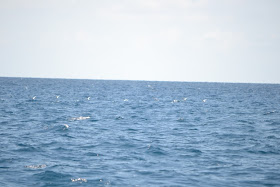They are called Screw Pines (Adanアダン). The fruit looks yummy but actually it is not suitable for human consumption (too tough, too much fiber). The smell was nice and sweet so there was no wonder so many insects were attracted to the fruit.
Still it looks tasty doesn't it!
Pacific Reef Egrets (Kurosagiクロサギ) were seen on almost every beach/rock-pool. There are dark morph ones like this and
white morph ones like this.
In Japanese they are called Kurosagi, which means a black heron, so some people call the white morph ones Shiro-Kurosagi (White Black Heron)! Confusing!
Eastern Cattle Egrets (Amasagiアマサギ) still have their summer plumage and they were after...
a tractor!
That reminded us of Red Kites, Buzzards, Rooks, Jackdaws and Gulls in Wales:)
Whiskered Terns (Kurohara-ajisashiクロハラアジサシ) were fishing and resting in and over the rice fields.
From a ferry to a small island called Kuroshima, we were able to see terns flying over the ocean and resting on poles. Some are Black-naped Terns (Eriguroajisashiエリグロアジサシ), others could be Roseate Terns (Beniajisashiベニアジサシ) or Greater Crested Terns (Ooajisashiオオアジサシ).
There were very few gulls around the Yaeyama Islands at this time of year so what you could see over the sea were all terns.
At the Kuroshima Harbour. I personally hate those concrete blocks but at least the tern found it a good resting place...
Zitting Cisticolas (Sekkaセッカ) were zitting everywhere. They are tiny birds but their calls are loud enough to spot them:)
Oopsy daisy!
He perched very close to us and started preening. If only he had perched on the other side of the sun... well, never mind.
At the high tide, lots of waders gathered near the beach/on the rock.
Kentish Plovers (Shirochidoriシロチドリ) are resident birds on the island.
Turnstones (Kyojoshigiキョウジョシギ) were turning stones:)
Pacific Golden Plovers (Munaguroムナグロ) were seen on the coast and in the rice/cattle fields as well.
Greenshanks (Aoashishigiアオアシシギ) were one of the easiest waders to spot because of their size.
A dog-walker disturbed them and they all scattered...
A Grey-tailed Tattler (Kiashishigiキアシシギ) flew off too...
When we were with Mr Kobayashi, he showed us a Cinnamon Bittern (Ryukyu Yoshigoiリュウキュウヨシゴイ), Slaty-legged Crake (Ookuinaオオクイナ), Osprey (Misagoミサゴ), Brown Booby (Katsuodoriカツオドリ), Eurasian Scops Owl (Ryukyu Konohazukuリュウキュウコノハズク), Spotted Redshank (Tsurushigiツルシギ), Ruff (Erimakishigiエリマキシギ), Greater Sand Plover (Oomedaichidoriオオメダイチドリ), Marsh Sandpiper (Koaoashishigiコアオアシシギ), Wood Sandpiper (Takabushigiタカブシギ), Sharp-tailed Sandpiper (Uzurashigiウズラシギ), Red-necked Stints (Tounenトウネン), Long-toed Stints (Hibarisigiヒバリシギ), Curlew Sandpipers (Saruhamashigiサルハマシギ), Scaly-breasted Munias (Shimakinparaシマキンパラ), White-breasted Waterhens (Shiroharakuinaシロハラクイナ) and quite a few Snipes (either Pin-tailed Snipe (Harioshigiハリオシギ), Swinhoe's Snipe (Chujishigiチュウジシギ) or Latham's Snipe (Oojishigiオオジシギ)).
The day-out and night-tour with Mr Kobayashi were both just incredible and we really recommend his tours to anyone who plans to go to the island for bird-watching and who would like to know/see the birds and wildlife there.
Here is Kobayashi-san's site again.
http://www.seabeans.net/
Thank you very much, Kobayashi-san!



















No comments:
Post a Comment